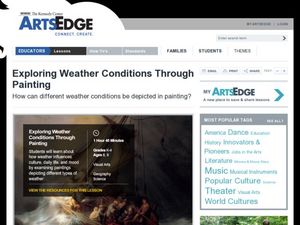Curated OER
Mobile-ize
Second graders, using a minimum of four space figures, create a mobile. They use a "Draw" program to first plan out their figure.
Curated OER
Extra Terrestial Excursions
Fourth graders determine how long it would take to fly to each of the planets in the solar system. They do two calculations: one, if they were using conventional jet, the other if they were using the fastest spacecraft possible.
Curated OER
Exploring Weather Conditions Through Painting
Your advanced class will paint a picture of a particular weather condition. In this painting lesson students describe elements of art in pieces of artwork. They analyze the weather and seasons in the artwork. The students use paper,...
Curated OER
Mission Meals
Young scholars engage in a investigation of the types of meals that astronauts eat in space while examining the types of nutritional elements needed for optimum physical tasks in space. They are given different foods and then document...
Curated OER
Rocking the Boat
Students work together to discover the concepts of stability and equilibrium. They examine how equilibrium is related to an item's center of mass. They create their own action scene in a literacy activity.
Curated OER
Please Ex-Planet
Seventh graders create a model of an earth centered solar system and a model of the sun centered solar system. As a class, they discuss why the earlier astronomers believed their model and why it changed when evidence arose that this...
Curated OER
Color Mixing
High schoolers, using the Colorcube 3D model, explore how to mix an entire color space with only the primary colors: cyan, magenta and yellow.
Curated OER
Letters to the Man in the Moon
Students write and communicate mathematically with their classmates. They discuss the mathematics that it took to allow us to conquer space and land on the moon. They sketch a plaque they would leave on the moon.
Curated OER
Stars and the Sun
Sixth graders research and state the differences between different stars and the sun. They tie the magnificence of space with the science fiction novel, "I Robot." Several worksheets and discussions are also covered within this lesson plan.
Curated OER
Vocabulary Building - Brainstorming
Students learn new vocabulary words in ways that are fun and enriching. They brainstorm lists of words to be used in sentences, stories, or conversations.
Curated OER
Recognizing 4 major photojournalism techniques to improve quality and interest in pictures
Students learn four basic techniques that enable them to not only tell the story, but also to make the viewer wonder what might have been left out of the photo.
Curated OER
Surface Tension-Driven Flows
Students learn how surface tension changes can cause fluids to flow.
Curated OER
Everybody Needs a Rock
Second graders examine science non-fiction books in the 500 section of the media center. They listen to Byrd Baylor's, Everybody Needs a Rock, and write a sentence that tells why everyone does need a rock. They illustrate the sentence.
Curated OER
Model Organisms: The Genes We Share
In this genetics activity, students access a website to learn about how human genes mutate to cause heritable disorders such as Huntington disease. Students use the information on this website to complete 12 short answer questions.
Curated OER
Ballet and Classical Music
Fourth graders explore ballet. In this dance and music humanities lesson, 4th graders practice ballet positions and play a card game using French ballet vocabulary. Students count beats in rhythm patterns and listen to classical music...
Curated OER
Character in a Box
Partners choose, research, and analyze fictional or historical characters and design character life boxes to represent them. They also compose a rhyme royal, which they understand inductively by deconstructing examples. Based largely on...
Curated OER
Setting the Story: Techniques for Creating a Realistic Setting
“It was a dark and stormy night.” Thus begins the 1830's novel Paul Clifford and, of course, all of Snoopy’s novels! Encourage young writers to craft settings for their stories that go beyond Edward Bulwer-Lytton’s often-mocked phrase...
John F. Kennedy Center
Baila! Latin Dance in the Spanish Classroom
One, two, three. One, two, three. Invite your language learners to practice the steps for researching and presenting information. Each small group has the task of explaining one Latin dance in full detail.
Desert Discovery
Saguaro Parts
Young biologists identify the basic structures of a saguaro cactus. They study the functions of each of the structures, and label them on a picture of a saguaro cactus embedded in the plan. This simple, and easy-to-implement lesson would...
Curated OER
Revised: Adventures in Earth Day: Why Do We Care About Our Environment? - Biology Teaching Thesis
To describe the ecological and aesthetic importance of the Potomac River, Middle schoolers name the ways in which the river's values are jeopardized and explain the purpose of Earth Day. They write a response to a newspaper article in a...
Curated OER
Characterization in Literature
High schoolers discover characterization techniques and methods. In this characterization lesson, students choose favorite fiction characters and discuss what makes a character come alive. High schoolers then describe a family member or...
Curated OER
The Universe
Fifth graders identify and discuss responsibilities of careers related to the study of the universe, such as an astronomer or an astronaut. They compare what the world looks like now to what it might look like in the year 3000.
Curated OER
Tolerance: Words that Hurt/Words that Heal
Students "role-play" the part of a person who says unkind things and are photographed while doing so. They then act out a story about making friends. They practice saying kind things and are photographed. Word bubbles are added...

























